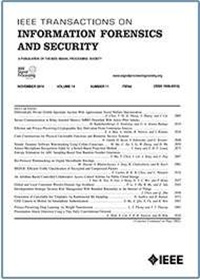TruVRF:面向机器学习的三粒度验证
IF 8
1区 计算机科学
Q1 COMPUTER SCIENCE, THEORY & METHODS
IEEE Transactions on Information Forensics and Security
Pub Date : 2025-04-30
DOI:10.1109/TIFS.2025.3565991
引用次数: 0
摘要
被遗忘权激励了机器遗忘,但一个关键的挑战仍然存在:缺乏可靠的方法来验证模型提供者进行的遗忘。这种差距使不诚实的模型提供者容易欺骗数据提供者。目前的方法通常依赖于侵入性方法,如后门注射。然而,它带来了安全问题,并且也不适用于遗留数据——已经发布的数据。为了应对这一挑战,本工作初始化了第一个非侵入性的学习验证框架,该框架在三粒度(类、卷、样本级别)上运行,以评估机器学习的数据真实性和卷完整性。在本文中,我们提出了一个名为TruVRF的框架,包含三个Unlearning-Metrics,每个都针对不同类型的不诚实模型提供者或服务器(忽略服务器,懒惰服务器,欺骗服务器)进行定制。TruVRF利用非侵入性模型敏感性来实现多粒度的学习验证。具体来说,unlearning - metric - i检查被删除的类是否与数据贡献者的取消学习请求相匹配,unlearning - metric - ii测量未学习数据的数量,unlearning - metric - iii验证特定的未学习样本与请求的删除的对应关系。我们在三个数据集上对TruVRF的有效性进行了广泛的评估,值得注意的是,我们还评估了TruVRF在人脸识别数据集的实际应用中的有效性和计算开销。我们的实验结果表明,TruVRF实现了鲁棒的验证性能:unlearn - metric - i和-III对不诚实服务器的平均验证准确率超过90%,而unlearn - metric - ii的推理偏差保持在4.8%到8.2%之间。此外,TruVRF还展示了在不同条件下的通用性,包括不同数量的未学习类和样本量。值得注意的是,TruVRF应用于两种最先进的学习框架:SISA(在奥克兰21年发表)和遗忘性学习,分别代表了精确和近似的学习方法,这证实了TruVRF的实用性。此外,我们围绕TruVRF进行了广泛的评估,包括消融实验、计算开销的权衡和模型灵敏度的鲁棒性等。本文章由计算机程序翻译,如有差异,请以英文原文为准。
TruVRF: Toward Triple-Granularity Verification on Machine Unlearning
The right to be forgotten has incentivized machine unlearning, but a key challenge persists: the lack of reliable methods to verify unlearning conducted by model providers. This gap facilitates dishonest model providers to deceive data contributors. Current approaches often rely on invasive methods like backdoor injection. However, it poses security concerns and is also inapplicable to legacy data—already released data. To tackle this challenge, this work initializes the first non-invasive unlearning verification framework which operates at triple-granularity (class-, volume-, sample-level) to assess the data facticity and volume integrity of machine unlearning. In this paper, we propose a framework, named TruVRF , encompasses three Unlearning-Metrics, each tailored to counter different types of dishonest model providers or servers (Neglecting Server, Lazy Server, Deceiving Server). TruVRF leverages non-invasive model sensitivity to enable multi-granularity verification of unlearning. Specifically, Unlearning-Metric-I checks if the removed class matches the data contributor’s unlearning request, Unlearning-Metric-II measures the amount of unlearned data, and Unlearning-Metric-III validates the correspondence of a specific unlearned sample with the requested deletion. We conducted extensive evaluations of TruVRF efficacy across three datasets, and notably, we also evaluated the effectiveness and computational overhead of TruVRF in real-world applications for the face recognition dataset. Our experimental results demonstrate that TruVRF achieves robust verification performance: Unlearning-Metric-I and -III achieve over 90% verification accuracy on average against dishonest servers, while Unlearning-Metric-II maintains an inference deviation within 4.8% to 8.2%. Additionally, TruVRF demonstrates generalizability across diverse conditions, including varying numbers of unlearned classes and sample volumes. Significantly, TruVRF is applied to two state-of-the-art unlearning frameworks: SISA (presented at Oakland’21) and Amnesiac Unlearning, representing exact and approximate unlearning methods, respectively, which affirm TruVRF ’s practicality. In addition, we conducted extensive evaluations around TruVRF , including ablation experiments, trade-offs in computational overhead, and the robustness of model sensitivity, among others.
求助全文
通过发布文献求助,成功后即可免费获取论文全文。
去求助
来源期刊

IEEE Transactions on Information Forensics and Security
工程技术-工程:电子与电气
CiteScore
14.40
自引率
7.40%
发文量
234
审稿时长
6.5 months
期刊介绍:
The IEEE Transactions on Information Forensics and Security covers the sciences, technologies, and applications relating to information forensics, information security, biometrics, surveillance and systems applications that incorporate these features
 求助内容:
求助内容: 应助结果提醒方式:
应助结果提醒方式:


